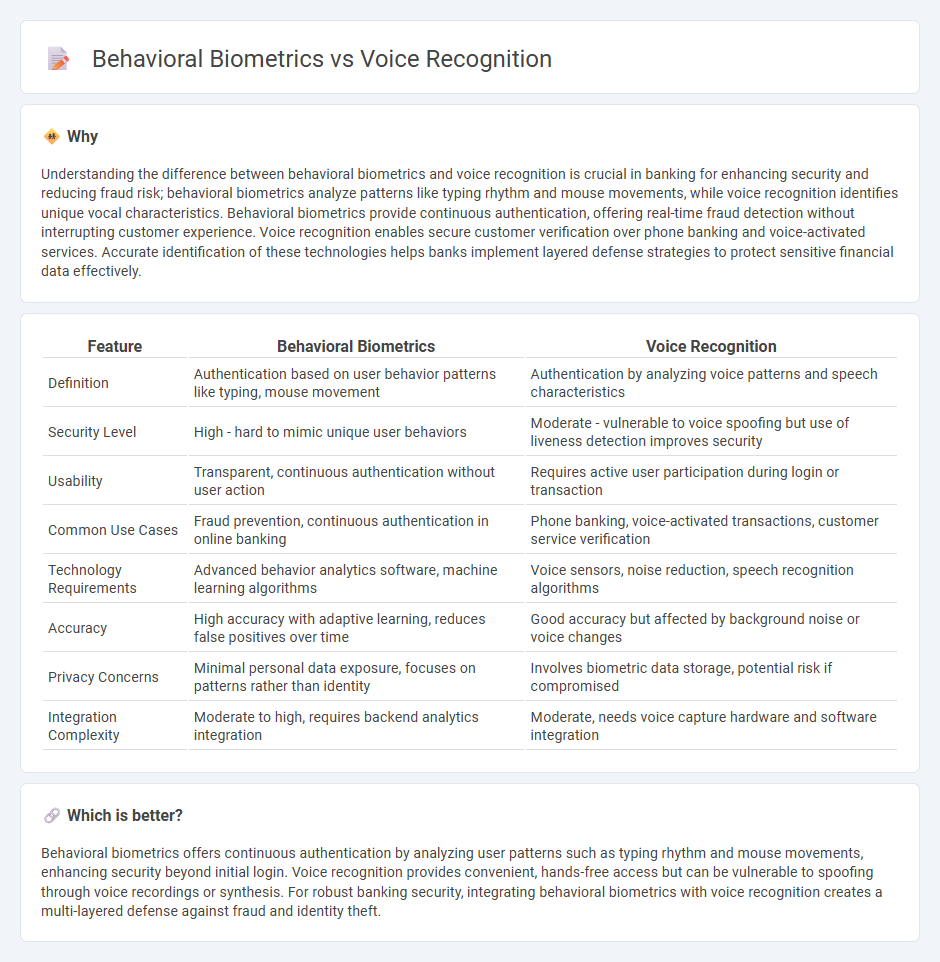
Behavioral biometrics analyzes unique patterns in user behavior such as typing rhythm, mouse movements, and device interaction to enhance banking security. Voice recognition technology identifies individuals by analyzing vocal characteristics, enabling secure and convenient authentication for financial transactions. Explore the comparative advantages of behavioral biometrics and voice recognition to strengthen your banking security measures.
Why it is important
Understanding the difference between behavioral biometrics and voice recognition is crucial in banking for enhancing security and reducing fraud risk; behavioral biometrics analyze patterns like typing rhythm and mouse movements, while voice recognition identifies unique vocal characteristics. Behavioral biometrics provide continuous authentication, offering real-time fraud detection without interrupting customer experience. Voice recognition enables secure customer verification over phone banking and voice-activated services. Accurate identification of these technologies helps banks implement layered defense strategies to protect sensitive financial data effectively.
Comparison Table
| Feature | Behavioral Biometrics | Voice Recognition |
|---|---|---|
| Definition | Authentication based on user behavior patterns like typing, mouse movement | Authentication by analyzing voice patterns and speech characteristics |
| Security Level | High - hard to mimic unique user behaviors | Moderate - vulnerable to voice spoofing but use of liveness detection improves security |
| Usability | Transparent, continuous authentication without user action | Requires active user participation during login or transaction |
| Common Use Cases | Fraud prevention, continuous authentication in online banking | Phone banking, voice-activated transactions, customer service verification |
| Technology Requirements | Advanced behavior analytics software, machine learning algorithms | Voice sensors, noise reduction, speech recognition algorithms |
| Accuracy | High accuracy with adaptive learning, reduces false positives over time | Good accuracy but affected by background noise or voice changes |
| Privacy Concerns | Minimal personal data exposure, focuses on patterns rather than identity | Involves biometric data storage, potential risk if compromised |
| Integration Complexity | Moderate to high, requires backend analytics integration | Moderate, needs voice capture hardware and software integration |
Which is better?
Behavioral biometrics offers continuous authentication by analyzing user patterns such as typing rhythm and mouse movements, enhancing security beyond initial login. Voice recognition provides convenient, hands-free access but can be vulnerable to spoofing through voice recordings or synthesis. For robust banking security, integrating behavioral biometrics with voice recognition creates a multi-layered defense against fraud and identity theft.
Connection
Behavioral biometrics and voice recognition both enhance banking security by analyzing unique customer patterns for authentication. Behavioral biometrics monitors user actions such as typing rhythm and device interaction, while voice recognition verifies identity through vocal characteristics. Combining these technologies reduces fraud and improves the accuracy of customer verification in digital banking platforms.
Key Terms
Authentication
Voice recognition systems analyze unique vocal characteristics such as pitch, tone, and speech patterns to verify user identity, offering seamless and non-invasive authentication. Behavioral biometrics leverage patterns in user interactions, including typing rhythm, mouse movements, and navigation habits, providing continuous, adaptive security against fraud and identity theft. Explore the comparative strengths and application scenarios of voice recognition and behavioral biometrics in authentication to enhance your understanding of secure access technologies.
Fraud Prevention
Voice recognition analyzes unique vocal patterns to verify identity and detect fraudulent calls in real time, enhancing security for banking and e-commerce platforms. Behavioral biometrics examines user interactions such as typing rhythm, mouse movements, and device handling to continuously authenticate users and identify anomalies indicative of fraud. Explore more about how these technologies revolutionize fraud prevention strategies.
User Experience
Voice recognition enhances user experience by offering hands-free, intuitive access and improving accessibility for diverse users. Behavioral biometrics analyze patterns like typing rhythm and mouse movements to provide seamless, continuous authentication without interrupting the user flow. Explore detailed comparisons to understand which technology best suits your UX goals.
Source and External Links
What is Voice Recognition? - Arm - Voice recognition is a deep learning technique used to identify, distinguish, and authenticate a particular person's voice by evaluating unique voice biometrics such as frequency, pitch, and natural accent, and is often used as a secure, contactless biometric method commonly paired with facial recognition for enhanced security.
What is Voice Recognition and How Does it Work? - TechTarget - Voice recognition allows machines to identify the speaker by analyzing voice frequency, accent, and speech flow, enabling hands-free interaction and user verification, though it differs from speech recognition, which interprets the spoken words themselves.
Speech recognition - Wikipedia - Speech recognition is the technology for converting spoken language into text, often involving training to improve accuracy, and is distinct from voice recognition, which identifies the speaker rather than the content of speech.
 dowidth.com
dowidth.com